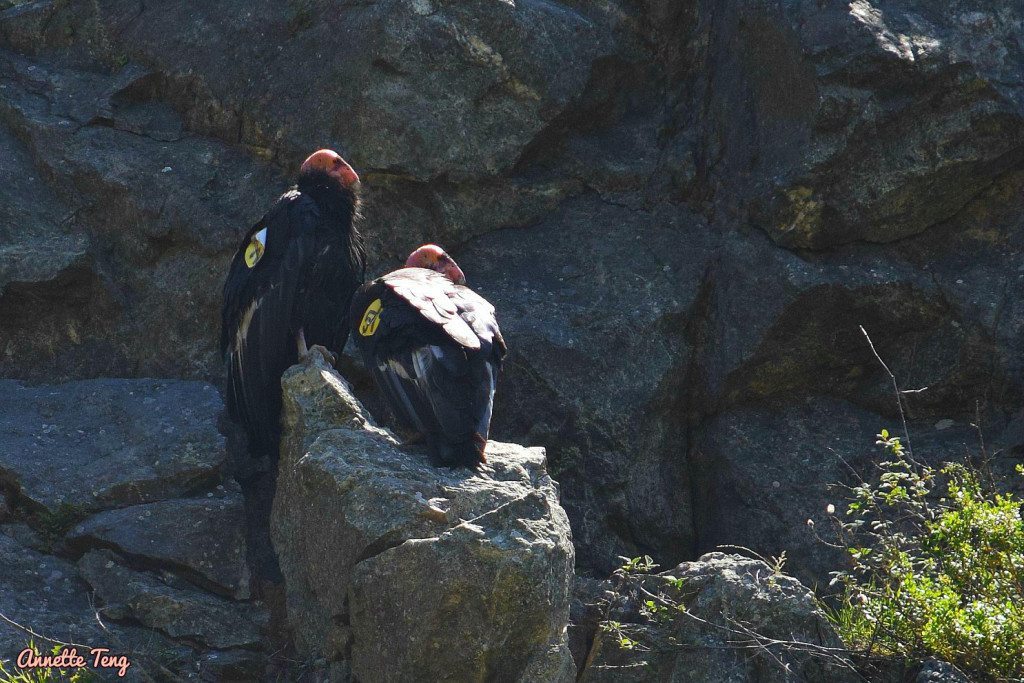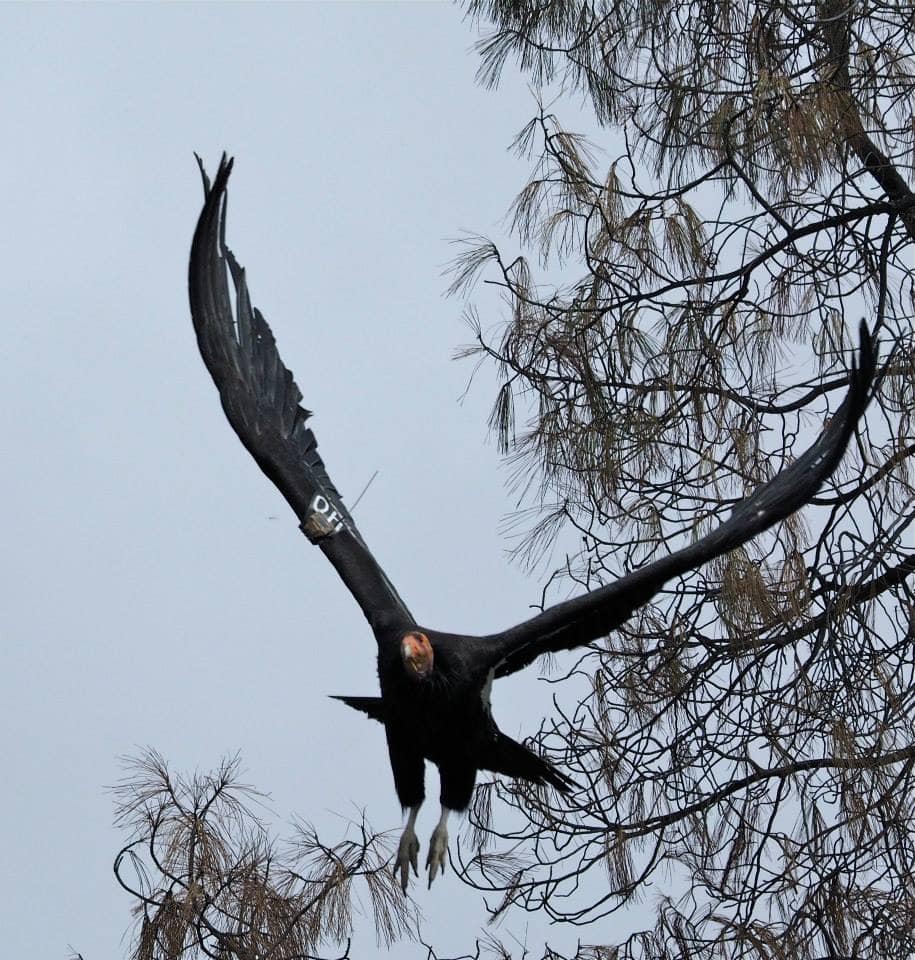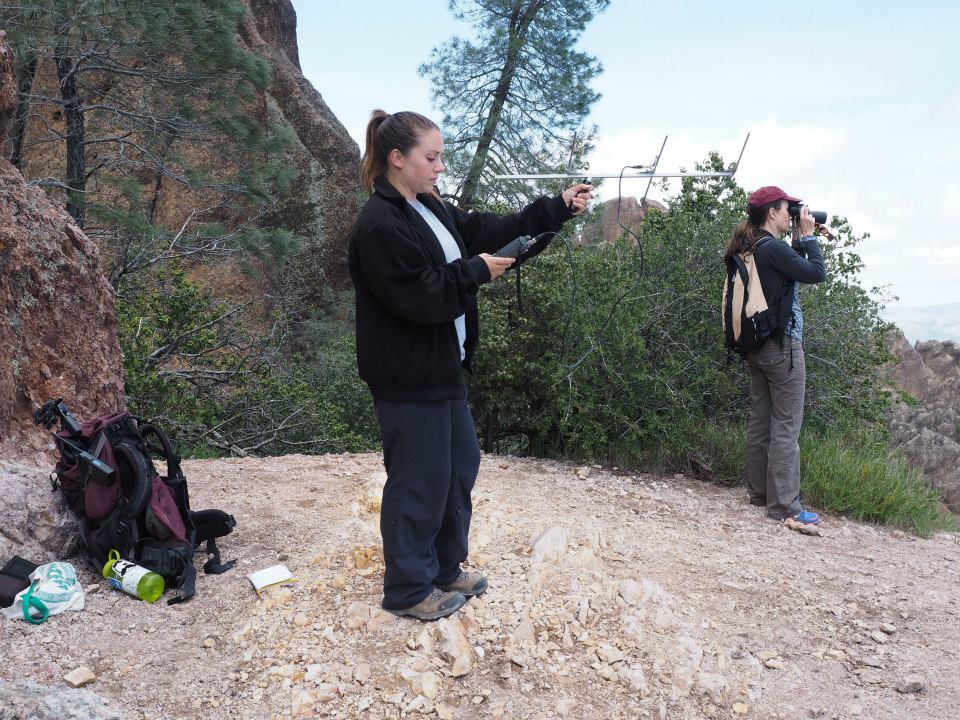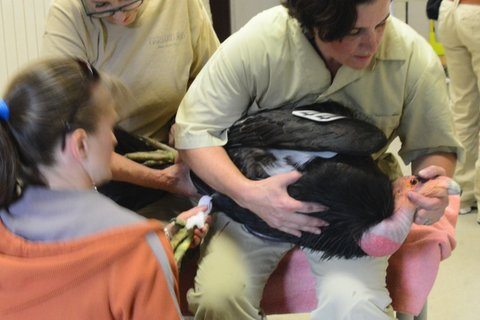Experiencing Condors during Birdathon
By Leslie Jacoby
Newsflash, April 20, 2015: Conservationists thought one of the few numbered wild California Condors had disappeared somewhere in the vast geographical landscape around Grand Canyon National Park. That was February 2015. Its number had been recorded, as is done with each and every known wild condor. Today, located near the small town of Cortez, Colorado, the rapscallion had been sighted and photographed by one of the seasonal park rangers, Franz Carver. The condor’s tag read “N8,” and he was in fact the missing two-year-old male. The short trail of events made the news, and I smiled upon hearing it.
* * * * *
Only two days prior to this newsflash, an excited Birdathon group from Golden Gate Bird Alliance stood on a dirt turnout next to a hairpin curve on Highway 1, south of Big Sur, admiring a couple of wild California Condors: Tag numbers 251 and 222.
They were a male and a female, sunning themselves on the rocky cliffs in the unusually warm spring morning. Intermittently, one or the other preened or fluffed a feather. We set up the birding scope and each of us took a turn viewing the rare birds through the high-power magnifying lens.


Andy Kortman, our young guide from Ventana Wildlife Society, happily filled us in on the backstory: Number 222 was living with her second mate, Number 251. Andy explained why, if condors mate for life, Number 222 would be willing to take up a new partner. It seems that her first mate had been found wounded on the side of a local road, his beak broken, which had caused a serious feeding problem. He was taken to the Oakland Zoo for medical care. When he was returned to Big Sur, alas, his “wife” had moved on to mate with another. During our visit, Number 222 and Number 251 guarded a single egg, which was due to hatch soon.
April was Birdathon month. It’s the time of year for looking up to the skies to fulfill our passion for sighting migrating geese, wayward raptors, and chirrups of local birds excited by new spring. I look forward to every springtime in northern California, both for the wonderful birding and for GGBA’s Birdathon.
I was fully on board this year and committed to Birdathon’s goals. I started my first fundraising webpage. I scoured the snail-mail newsletter and planned to take a number of Birdathon trips, including mist-netting at Point Blue (formerly PRBO) in West Marin and spring bird watching at Point Reyes. I also cleared my calendar for the Ventana Wilderness trip, where we would search for one of the rarest birds on the Earth: the California Condor or Gymnogyps californianus.
We met early at a rustic site next to Andrew Molera State Park and met up with Andy, a naturalist and former member of a hard rock band: What a delight! Over a two-hour schlep, Andy drove a van fully loaded with fourteen other birders down serpentine Highway 1 in search of condors.
I knew a little history of the largest land bird in North America. I knew that in the 1970s and 1980s a battle raged over how best to save the nearly extinct “New World Vulture”– trapping them to start a captive breeding program, or allowing them to remain free in the wild. The issue divided the conservation community. National Audubon supported the captive breeding program, while Golden Gate Bird Alliance supported the alternative of letting them live (and possibly go extinct) in the wild.
By 1982, there were only 22 wild condors remaining, and the advocates for captive breeding won the day. The last wild condor was captured in 1987.
By all logic, this could have been the end of wild days for these feathered creatures. Instead, their reintroduction into the wild stands as one of the most miraculous conservation efforts ever achieved in California, or for that matter, in the world.
As we snaked along the rocky cliff road, Andy gave a wonderfully entertaining overview of the project. We were told to keep a lookout from the van windows. We learned several key sighting tips:
- Condors are heavier than Turkey Vultures (TVs), so they don’t wobble in the wind when soaring.
- Condor feathers are jet black and purer white, compared to the TV’s grey and beige.
- The California Condor is the only vulture to feed on sea mammals such as whales and seals. In fact, Lewis and Clark noted a California Condor feeding on a whale beached on the Columbia River in Washington state.

We pulled into a dusty gravel turnoff, climbed out of the cramped van, and walked over to the edge of the cliff to look down at the ocean cove below. We sighted eight TVs in a vigil over a rookery of lively sea lion pups, probably hoping one would be destined for a premature death. Just yards out at sea, the pod of sea lions indicated itself by a show of “hands” or flippers in the air — actually an aquatic maneuver to cool their blubbery bodies down in our increasingly warmer oceans. We anxiously hoped to see a California Condor at any minute interloping into the carrion watch.
Andy pulled out his telemetry equipment, which looked like a television antenna from the 1960s, and opened the long fingers of metal attached to a single pole. All the while, he gave us a quick lesson in listening to the beeps that represented radio signals from the condor’s tracking devices. Two condors were in our vicinity, but we were not able to catch a glimpse. That would come on our next stop.

My story ends back at the dirt turnout next to the Highway 1 hairpin curve, where we found those male and female condors, Numbers 222 and 251, as well as a mating pair of Peregrine Falcons.
As we took several turns on the scope, a fashionably-dressed woman approached me and asked, “What are you looking at?” I told her, and soon many of the other birders in our group chimed in with the unique history of our great wild condorss. We were newly-minted experts.
It turned out our visitor was from China. When we offered her views from the scope, she gave out gasps of joy and called out in Chinese for her three companions – equally well dressed – to come look too. I thought to myself: This is what GGBA Birdathon is all about – sharing the joys of the natural birding world.
Next year, I will be the first in line when the month of April rings.
___________________
Leslie Jacoby is a native Californian who teaches at San Jose State University. She writes for a living, studies medieval falconry practices, and is an avid birder. She lives in Berkeley.
——————————
Condor recovery talk – Wednesday June 3
Learn about how the Oakland Zoo and Ventana Wildlife Society are partnering to help condors recover from lead poisoning, a major threat to their survival. GGBA is co-sponsoring a talk on Wednesday June 3 by Oakland Zoo veterinarian Dr. Andrea Goodnight and Kelly Sorenson, Executive Director of Ventana Wildlife Society. Tickets available at the door, from $12 to $20 (sliding scale). Doors open at 6:30 and the talk begins at 7 p.m.: Come early since seating is limited. Proceeds benefit the California Condor Recovery Project. At the Marian Zimmer Auditorium at the Oakland Zoo, 9777 Golf Links Road, off of Highway 580. Click here for more info.

